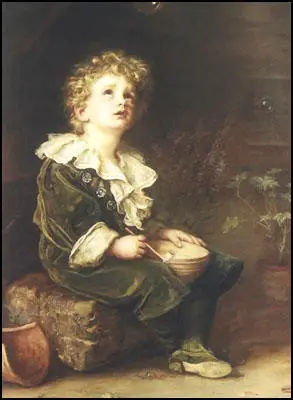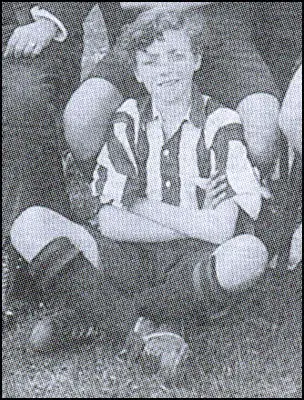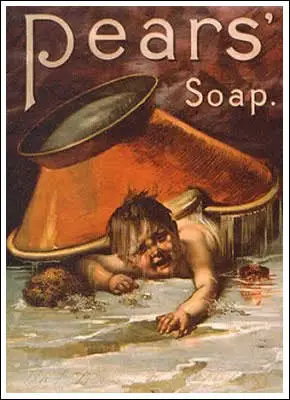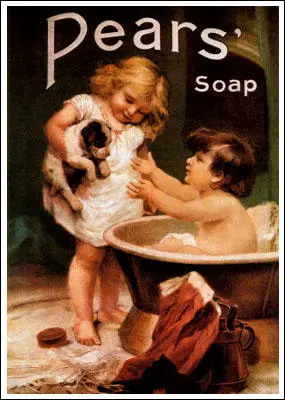West Ham's Anthem
In the Spring 2005 edition of Soccer History, the West Ham United historian, John Northcutt, published an article on why the club fans sing I'm Forever Blowing Bubbles. He points out that the song was written in 1919 and became a popular hit in the UK in the early 1920s. At the time it was fairly common for football crowds to sing popular songs together. At Upton Park the club employed the Beckton Gas Works Band to play before the game started. One of the songs they played was I'm Forever Blowing Bubbles. However, the mystery remains, why did the Upton Park crowd adopt the song as its anthem?
John Northcutt spends sometime discussing the most popular theory of why this happened. It is a fascinating idea as it involves a famous painting, a soap advert and a young West Ham player named Will Murray.
In 1886 Sir John Everett Millais, one of the founders of the Pre-Raphaelite Brotherhood, painted a portrait of his five-year old grandson watching a soap bubble he had blown through a clay pipe (erroneously, Northcutt claims it was painted in 1829). The painting caused a sensation as it was completely different from his previous work. It was first exhibited under the title A Child's World in Grosvenor Gallery in London, and was acquired by Sir William Ingram of the Illustrated London News. The painting was reproduced and presented in the magazine as a colour plate, where it was seen by Thomas J. Barratt, managing director of A. & F. Pears. Barratt purchased the original painting from Ingram for £2,200 which gave him exclusive copyright on the picture. Millais' permission was sought in order to alter the picture by the addition of a bar of Pears Soap, so that it could be used for the purposes of advertising. The painting/advert now became known as "Bubbles".
Northcutt then goes on to argue that as the Pears Soap Works was based in Canning Town, there would have been a lot of Bubbles posters around the ground at the time the song was popular. Therefore, the fans would therefore have associated the song and the poster together. There are several things wrong with this argument. First of all, Pears was a national company and their posters would be no more likely to have been around the Upton Park ground at that time than any other stadium. More importantly, Pears were no longer using the Millais' Bubbles painting in the 1920s.The next stage of the story is even more unconvincing. John Northcutt argues: "The West Ham Boys team often played their home games at Upton Park in front of huge crowds and one of the team, Will Murray, having fair curly hair resembled the boy in the advert. He soon gained the nickname Bubbles Murray and whenever he played the crowd would sing I'm Forever Blowing Bubbles, this being the popular song of the day."


Wikipedia has a slightly different version of this story. It claims that Murray was given the nickname "Bubbles" by his headmaster Cornelius Beal. It goes on to argue that Murray "had an almost uncanny resemblance to the boy in the famous Bubbles painting by Millais used in a Pears soap commercial of the time."
There is a photograph in existence of Murray in 1921. He looks nothing like the Bubbles painting. Nor could he, as the painting shows a five year old boy, not a teenager. He has dark rather than fair hair. It is fairly curly, but nothing like the original painting or indeed the Pears adverts that were in existence in the early 1920s.
The other important point is that the record books show that Will Murray never played for West Ham first team. His early promise was not fulfilled. However, is it really credible that the Upton Park fans would sing a song about a player who never made it into the first-team?


The club's historian, John Helliar, added to the story when he wrote an article, The Story of Bubbles (17th October, 2009) on the West Ham United's official website. He follows the claim made by John Northcutt (not referenced) that "Billy Bubbles Murray, so-called because of his distinct and almost uncanny resemblance to the boy in the famous painting by Millais". He goes on to add some more information on the story. Helliar quotes a letter from a former member of the Beckton Gas Works Band, to the Pensioners' Bulletin in 1983. He recalls that the band "were engaged by the West Ham United Football Club to play for 20 minutes before the kick-off and 10 minutes at the interval." He added: "We played Bubbles and it very quickly became a favourite with the crowd." The problem is that the man does not give a date for these performances. It could have been in the early 1920s that would give some support to the story about Murray . However, it could also have been in the 1930s when the promising schoolboy footballer was no longer a topic of conversation at Upton Park.
John Helliar does at least expose the myth that I'm Forever Blowing Bubbles was sung by West Ham fans before the start of the 1923 Cup Final at Wembley. His research shows that the song adopted at that match was Till We Meet Again.
Despite the obvious flaws in the Will "Bubbles" Murray story it became the official explanation when it featured on BBC television last year. As is often the case with television, the story was told as fact rather than speculation.
John Northcutt, in his original article in Soccer History, made it clear that the story might not be true. To emphasise this he put forward two alternative theories. The first involves a FA Cup tie against Swansea City in 1922. Ian Nannestad has carried out research to show that I'm Forever Blowing Bubbles was sung at the Vetch Field in the early 1920s. Nannestad quotes from The Sporting News (8th January, 1921) that the Swansea crowd sung the song before a FA Cup tie against Bury. "Then came the ever popular Bubbles, and the crowd simply yelled. The spectators on the main bank took their cue from the Mumbles end, and there was one tremendous sway, together with the singing, on the part of about 25,000."
Northcutt speculates that the West Ham crowd might have developed this tradition after hearing the Welsh fans singing this song in the FA cup game played against Swansea in 1921. Well, this story has been dashed in an article that appears in the current edition of Soccer History. Nannestad has studied newspaper reports of the game and according to The Football Post "there was no singing" before the game.
This raises the issue of why West Ham historians such as John Northcutt and John Helliar have not been able to find newspaper reports in the 1920s and 1930s that remark on the fans singing I'm Forever Blowing Bubbles at Upton Park. If they had found such reports, they would surely have used them in their articles.
Northcutt also includes a third explanation for the singing of Bubbles. He points out that West Ham historian, Brian Belton, has argued that Bubbles was sung as crowds gathered during air raids in shelters and underground stations in the East End during the Second World War. This led to a rise in communal singing by the general public to raise morale. According to Belton, the first time the song was reported to be sung by West Ham fans was during the 1940 League War Cup Final at Wembley. This was a game that the Irons won and maybe the fans took it as a good luck omen. Anyway, that appears to me to be the most logical reason why the fans sing I'm Forever Blowing Bubbles at Upton Park.
